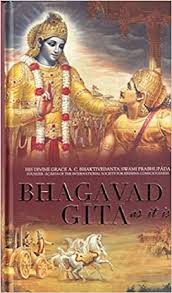Reflections on Habit Formation: Insights from "Atomic Habits" and the Bhagavad Gita
- Suman Basu

- Sep 4, 2024
- 5 min read
Reflections on Habit Formation: Insights from "Atomic Habits" and the Bhagavad Gita
Introduction
I recently completed Atomic Habits by James Clear, and I found the book quite impressive. It offers practical tips on correcting habits and eliminating bad ones. Some key highlights include:
The Power of Tiny Habits: Small changes, when made consistently, can lead to significant outcomes. The author mentions that a 1% improvement daily can lead to a massive change over one year, as high as 37% of the self.
Habit Change Strategy:
Make it obvious: Create an environment where it is easy to access good habits and difficult to access bad ones.
Make it attractive: Create new practices that are more appealing by pairing them with other similar habits.
Make it easy: Reduce roadblocks and friction for the new habit.
Make it satisfying: Ensure that following the new habit feels good or provides immediate results.
Habit Loop: Identify the triggers causing the habit, which is essential for continuing or discontinuing the habit.
Identity-Based Habits: Instead of focusing on results, try to create a new identity aligned with the habit.
Avoiding Bad Habits: This involves creating a situation where it is difficult to commit the bad habit, making it more boring, and introducing roadblocks to that habit.
Overall, the book provided me with many practical steps for changing habits. However, I was reminded of the teachings in the Srimad Bhagavad Gita, which I consider our manual for life. I wanted to explore what Lord Krishna says about habit formation and controlling bad habits.
All credits and glories to Srila Prabhupada, as I am referring to "The Bhagavad Gita As It Is," written by Srila Prabhupada, and using his translations and purports.
Parallels Between "Atomic Habits" and the Bhagavad Gita
First, I would like to credit James Clear, as he has articulated something very similar to what the Bhagavad Gita has said. According to the Bhagavad Gita, habits are a consequence of one's mental state, actions, and spiritual growth. In Chapter 2, Lord Krishna introduces us to all of these concepts.
Sanskaras and Habit Formation
Over many lives, we develop patterns of habits that are deeply embedded in the mind, termed as sanskaras. This part of Mind is called "Chitta". These are the results of the mental impressions left by past actions, thoughts, and experiences. Our body has two components: the Gross Body (made of Earth, Water, Air, Fire, and Ether) and the Subtle Body (composed of Mind, Intelligence, and False Ego) (BG 7.4, 7.5). As the soul migrates from one body to another (BG 8.5), it leaves the Gross Body but carries the Subtle Body. Since the Mind is part of the Subtle Body, it carries the sanskaras from past lives, and thus many deep-rooted habits persist. Hence, we must accept that it is very difficult to change a habit instantly.
Lord Krishna directs us that only through our sadhana (spiritual practice) (Ch 4), determination (Ch 15), and regular, disciplined spiritual practice of devotional services, combined with confidence in the results and patience, can we make changes.
The Importance of Consistent Practice
As mentioned in Atomic Habits, the Bhagavad Gita also emphasizes the importance of daily sincere practice and regular improvement to start changing habits. The concept of the "Plateau of Patience" in Atomic Habits—which suggests that there will be times when there seems to be no change, but one must continue the practice—resonates with Chapter 6 of the Bhagavad Gita, where Lord Krishna says that determined, confident practice is necessary.
Lord Krishna has shown us that disciplined habits lead to self-realization. If we focus on self-realization rather than mundane sense gratification, we uplift our consciousness.
Controlling the Mind and Senses
Our senses are like unbridled horses, running in all directions, with the mind as the reins—chanchala, very fickle. Our intelligence is the charioteer, supposed to control the horses and the cart, with the soul as the passenger who fears that the senses, mind, and intelligence are taking him to the wrong destination. While the mind can control the senses, it is fickle, so it needs to be guided by intelligence. However, intelligence cannot control unless it is on a higher platform. Therefore, the knowledge of scriptures, guidance from a Guru, Acharyas, and Spiritual Masters can elevate the intelligence to a higher platform. The Bhagavad Gita (6.6) says, "For one who has conquered the mind, the mind is the best of friends; but for one who has failed to do so, the mind is the greatest enemy." This teaches us the importance of mental discipline.
Spiritual Quotient and Habit Formation
In this context, the Bhagavad Gita introduces the concept of the Spiritual Quotient (SQ), which is the sum total of Emotional Quotient (EQ), Intelligence Quotient (IQ), and Physical Quotient (PQ). Stephen Covey, in his book, mentions that SQ is the most fundamental of all quotients as it gives us direction in life. Without a developed Spiritual Quotient, our mind always leads to mundane sense gratification. If intelligence can provide the mind with a higher taste, it will not move from one point to another.
Positive and Negative Habits
The Bhagavad Gita (2.59-61) says that simply controlling bad habits won't succeed because the "taste of sense enjoyment" still lingers, and given the slightest opportunity, it will resurface. Thus, the path of self-realization and consciousness is crucial. When one is mindful of their actions and consciously chooses to cultivate positive habits, negative habits are naturally eliminated. The higher taste is the taste of God consciousness.
The Influence of the Gunas
There are three modes of nature: Sattva (mode of goodness), Rajas (mode of passion), and Tamas (mode of ignorance). These are the gunas, which control our intelligence and influence our behavior and habits (BG 3.7). Developing Sattvic gunas, such as a disciplined life, meditation on the holy name, and consuming clean food, leads to clarity of life and peace of mind, while following a Tamasic lifestyle leads to more stress, which in turn pushes us toward bad habits. Finally, the Lord says that if one goes beyond these three gunas and completely surrenders to Him, he alone can attain self-realization, liberation, and eligibility to return to Godhead.
Cultivating Positive Habits through Devotion
The Bhagavad Gita (2.61) says that simply trying to refrain from bad habits will not lead to success. Instead, we must provide the senses and mind with the "taste of higher nature." By developing the good habit of connecting with Krishna, we arm ourselves with the weapon of unadulterated devotion and absorption in Him. In our battle against temptation, such absorption can be both our shield and sword. As a shield, it saves us from feeling tormented when temptation arises; as a sword, absorption drives temptation out by filling our consciousness with Krishna.
By being steadfast in the culture of connecting (yoga) with the Divine Power, Krishna, negative habits are automatically repelled.
Karma Yoga and the Cultivation of Habits
In Chapter 3 on Karma Yoga, the Lord tells us that by performing one's duties as specified by the scriptures without attachment to the outcomes, we can cultivate the habit of dedicated work while remaining focused on the work itself, not the results. This practice helps build resilience and reduces anxiety over success or failure. Once we achieve this state, negative habits are repelled naturally.
Conclusion
In conclusion, while the book Atomic Habits by James Clear is incredibly useful, the Bhagavad Gita teaches us at a higher level that by striving for higher consciousness, bad habits can be corrected, leading to a permanent solution that ensures we do not fall back into them. To attain this stage, regular, determined practice of meditation on the holy name and leading a healthy lifestyle according to the Sattvic method is recommended.
Hare Krishna.





Comments